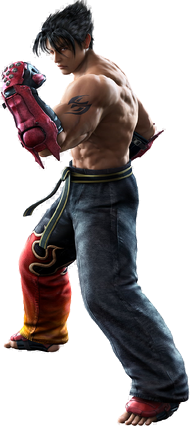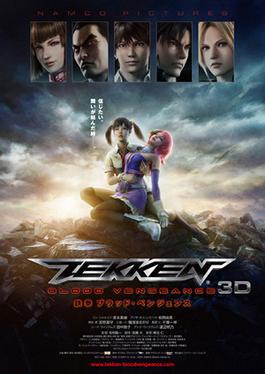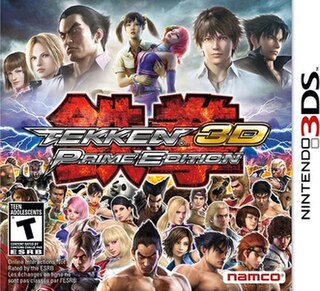Tekken is a Japanese media franchise centered on a series of fighting games developed and published by Bandai Namco Entertainment. The franchise also includes film and print adaptations.

Monolith Software Inc., trading as Monolith Soft, is a Japanese video game development studio originally owned by Namco until being bought out by Nintendo in 2007, best known for the Xenoblade Chronicles series of games. The company was founded in 1999 by Tetsuya Takahashi with the support and cooperation of Masaya Nakamura, the founder of Namco. Their first project was the Xenosaga series, a spiritual successor to the Square-developed Xenogears. Multiple Square staff would join Takahashi at Monolith Soft including Hirohide Sugiura and Yasuyuki Honne.
Super Smash Bros. is a crossover platform fighting game series published by Nintendo. The series was created by Masahiro Sakurai, who has directed every game in the series. The series is known for its unique gameplay objective which differs from that of traditional fighters, in that the aim is to increase damage counters and knock opponents off the stage instead of depleting life bars.

Jin Kazama is a fictional character and the protagonist of Bandai Namco's Tekken series. Introduced in the 1997 game Tekken 3, he has been the central character of the series from that game onwards. Trained by his grandfather Heihachi Mishima, Jin wishes to avenge the apparent death of his mother, Jun Kazama, at the hands of Ogre. However, Heihachi betrays Jin to awaken a genetic abnormality within the latter's body known as the Devil Gene, leading Jin to seek revenge against his grandfather in later installments.

Heihachi Mishima is a fictional character and one of the main antagonists of Bandai Namco's Tekken series. Introduced as a boss character in the first Tekken game from 1994, Heihachi is depicted as the abusive father of Kazuya Mishima and the CEO of a military firm known as the Mishima Zaibatsu, which was founded by his father, Jinpachi Mishima. Heihachi has served as the protagonist of Tekken 2 and Tekken 7, as well as a boss character in several other installments of the series.

Kazuya Mishima is a fictional character and one of the main antagonists of Bandai Namco's Tekken series. Debuting as the protagonist of the original game, Kazuya has since become one of the series' most prominent villains after serving as the penultimate boss of Tekken 2. The son of a wealthy zaibatsu CEO named Heihachi Mishima, Kazuya seeks revenge against his father for throwing him off a cliff years earlier. Kazuya becomes corrupted in later games, seeking to obtain more power and eventually coming into conflict with his own son, Jin Kazama. Kazuya Mishima possesses the Devil Gene, a demonic mutation, which he inherited from his late mother, Kazumi Mishima, which can transform him into a demonic version of himself known as Devil Kazuya. Devil Kazuya has often appeared as a separate character in older installments prior to becoming part of Kazuya's moveset in Tekken Tag Tournament 2 and later games. Kazuya Mishima is also present in related series media and other games.

Namco × Capcom is a tactical role-playing (RPG) crossover video game developed by Monolith Soft for the PlayStation 2 and published by Namco in 2005. The gameplay combines tactical RPG and action sequences during battles, featuring characters from video game series owned by Namco and Capcom. The narrative sees original characters Reiji Arisu and Xiaomu, operatives for paranormal investigative group Shinra, confront distortions bringing characters from other realities into their own.

Tales of the Abyss is an action role-playing game developed by Namco Tales Studio as the eighth main title in their Tales series in celebration of the series' 10th anniversary. Originally released for the PlayStation 2, the game was published by Namco in Japan in December 2005, and Bandai Namco Games in North America in October 2006. Its development team included director Yoshito Higuchi, producer Makoto Yoshizumi, and character artist Kōsuke Fujishima. The game features music by series composers Motoi Sakuraba and Shinji Tamura, and includes the opening theme song "Karma" by Bump of Chicken, which is replaced with the instrumental version in the western release. Namco has given Tales of the Abyss the characteristic genre name To Know the Meaning of One's Birth RPG. A port for the Nintendo 3DS handheld was released in Japan in June 2011, followed by an Australian and European release in November 2011 and a North American release in February 2012.
Arika is a Japanese video game developer and publisher. It was formed in 1995 by former Capcom employees. It was originally known as ARMtech K.K, but was later named Arika. The name of the company is the reverse of the name of the company's founder, Akira Nishitani, who along with Akira Yasuda, created Street Fighter II. Arika's first game was Street Fighter EX. It was successful and was followed up with two updates, and its two sequels Street Fighter EX2 and Street Fighter EX3. In 2018, they released a spiritual successor to both Street Fighter EX and Fighting Layer, titled Fighting EX Layer. From 2019 to 2021, Arika collaborated with Nintendo to create the battle royale games Tetris 99, Super Mario Bros. 35, and with Bandai Namco for Pac-Man 99. Arika is also known for the Tetris: The Grand Master series, the Dr. Mario series, starting with Dr. Mario Online Rx, and the Endless Ocean series.

Lars Alexandersson is a character from the Tekken fighting game franchise by Bandai Namco Entertainment. First introduced in the 2008 arcade game update Tekken 6: Bloodline Rebellion, he serves as the main protagonist of the Tekken 6 story mode.

Tekken X Street Fighter was a planned crossover fighting game that was being developed by Bandai Namco Entertainment. It was supposed to cross the universes of Namco's Tekken and Capcom's Street Fighter into one game, creating a roster from both franchises. The game was announced at the 2010 San Diego Comic-Con by Bandai Namco producer Katsuhiro Harada. The gameplay of Tekken X Street Fighter was going to feature the same 3D fighting game engine of the Tekken franchise, as opposed to Street Fighter X Tekken, which features the 2D-style gameplay of Street Fighter IV. Bandai Namco put the game's development on hold in 2016.

Tekken Tag Tournament 2 is a 2011 fighting game, the eighth installment in the Tekken fighting game series and the sequel to Tekken Tag Tournament. It was released for the arcades in September 2011. It received an update, subtitled Unlimited, in March 2012. A console version based on the update was released for PlayStation 3 and Xbox 360 in September 2012, prior to the update. It was ported to the Wii U as one of the system's launch titles in November 2012, subtitled Wii U Edition.

Tekken: Blood Vengeance is a 2011 Japanese animated science fiction martial arts film directed by Yōichi Mōri from a screenplay by Dai Satō, based on the video game series Tekken published by Namco Bandai Games. The film places focus on the young martial artist Ling Xiaoyu, who investigates experiments involving a supernatural curse related with the Mishima family, while befriending a robot named Alisa Bosconovitch. The two meet the test subject Shin Kamiya, who is being sought by his former friend Jin Kazama and his father Kazuya Mishima, but is also being used by Heihachi Mishima to set a new family fight.

Super Smash Bros. for Nintendo 3DS and Super Smash Bros. for Wii U, both commonly referred to together as Super Smash Bros. 4 or Smash 4, are 2014 crossover platform fighter video games developed by Bandai Namco Studios and Sora Ltd. and published by Nintendo for the Nintendo 3DS and Wii U video game consoles. It is the fourth installment in the Super Smash Bros. series, succeeding Super Smash Bros. Brawl. The Nintendo 3DS version was released in Japan on September 13, 2014, and in North America, Europe, and Australia the following month. The Wii U version was released in North America, Europe, and Australia in November 2014 and in Japan the following month.

Tekken 3D: Prime Edition is a 2012 fighting video game developed by Arika and Namco Bandai Games and published by Namco Bandai Games for the Nintendo 3DS. It is the second Tekken game to be released for a Nintendo platform after the 2001 video game Tekken Advance. The game is a graphically updated version of Tekken 6 for the Nintendo 3DS, supporting the handheld's 3D capabilities and maintaining a steady 60 FPS even when running in 3D; however, the 3D is disabled during wireless play. 40 characters and stages are included in the game, as well as 700 collectable Tekken cards. In addition, the 2011 film Tekken: Blood Vengeance is included in the package.

Digimon World Re:Digitize is a 2012 video game for the PlayStation Portable developed by tri-Crescendo and published by Bandai Namco Games on July 19, 2012. The fifth entry in the Digimon World series, itself part of the Digimon franchise, the game features a return to the gameplay mechanics introduced in the original game. An enhanced port was released for the Nintendo 3DS on June 27, 2013 under the title Digimon World Re:Digitize Decode.

Project X Zone is a crossover tactical role-playing video game for the Nintendo 3DS developed by Monolith Soft with assistance from Capcom and Red Entertainment and published by Namco Bandai Games. It is a follow-up to Namco × Capcom and features characters from Namco Bandai, Capcom, and Sega. The game was released on October 11, 2012 in Japan; June 25, 2013 in North America; and July 5, 2013 in Europe. Project X Zone received mixed to positive reviews upon release; praise went towards the game's cast, combat system, and presentation, but criticism was directed at its repetitive gameplay and confusing storyline.

Bandai Namco Studios Inc. is a Japanese video game developer headquartered in Kōtō, Tokyo and founded in 2012, with divisions in Singapore and Malaysia. Bandai Namco Studios is a subsidiary of Bandai Namco Entertainment, which itself is part of the wider Bandai Namco Holdings group. The company works under its parent company as a keiretsu; Bandai Namco Studios creates video games for home, arcade and mobile platforms, while Bandai Namco Entertainment handles the managing, marketing and publishing of these products.
















